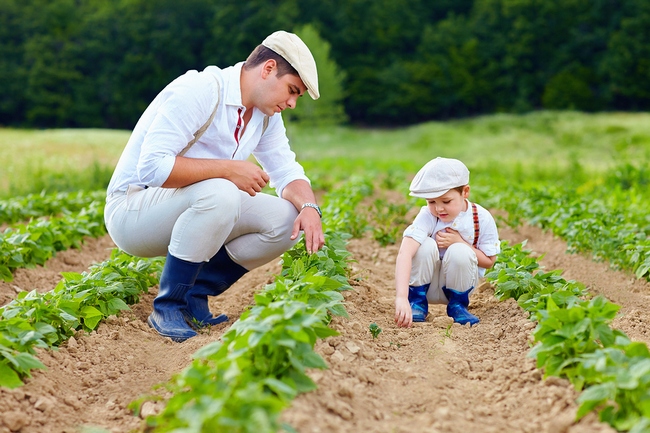- Make It Yourself Lavender Heart-Shaped Bath Bombs!
- 20 Things You Never Knew About “Down There”
- 12 Best Foods For Those Suffering From Arthritis Pain
- 12 Personal Hygiene Mistakes Almost Everyone Makes (Mom Never Told You About #4!)
- 15 Medicinal Plants And Herbs From The Cherokee People
- 12 Mind-Blowing Benefits Of Drinking Coconut Water During Pregnancy
- 12 Outstanding Winter Foods That Won’t Fatten You Up Like A Christmas Turkey
10 Tips for Urban Homesteaders

Photo credit: bigstock
6. Reduce Your Energy Consumption
Do you know how much energy your home consumes every month? Many gas and electrical companies will do energy checks/comparison charts at no charge. Find out what the major sources of electrical consumption are inside your home. Once you know which appliances use the most electricity, you can use them more wisely. Washers, refrigerators, clothes dryers, heaters, older furnaces, freezers, and air conditioners can all be huge energy hogs. Find ways to avoid using these appliances as much as possible by doing things the old fashioned way. Wash only full loads with cold water. Keep refrigerators and freezers on the lowest setting possible and as full as possible. If you need to take up extra space, fill empty plastic bottles, such as milk cartons, with water. Dry clothes outside on a clothesline as much as possible. Use fans more and air conditioning less. Put extra blankets on the bed and wear warmer clothes inside the house so you can turn the thermostat on the heater down.
7. Involve your children
Living a homesteading lifestyle is absolutely filled with the potential for educational opportunities that can include a lot of fun when the entire family is involved. Give your children their own tasks that are entirely theirs and allow your children to become a part of the homesteading life. Even very small children can feed chickens and collect eggs, water garden plants, and pick fruit from the ground. Teach them how to plant seedlings and ask for their help with whatever project you are working on. Older children can learn to cook and bake bread, care and clean up after livestock, do work in the garden, and learn how to make simple repairs. Yes, you might have to re-do a few plantings or tidy up after your children “help” you out, but this is how they become inspired to continue working on their own. Many people find that it helps if they buy some child sized tools so the work is easier for their smaller hands. Kids love to harvest what they have grown. Give them their own harvest basket and let them, literally, pick the fruit of their labors. Watch how they smile!
8. Engage the community
Although urban homesteading is about learning how to be more independent, it’s not about complete self-sufficiency. There is nothing better than building a network of community minded people, with a wide range of skills and resources, which are willing to share their knowledge with other community members. Urban homesteading works best when people in a community know that they can rely on one another if the need arises. Think about the Amish if you want to have a better idea about what urban homesteading is really like. Everyone in the community has very diverse abilities and through a co-operative lifestyle, everyone can flourish. Think of everyone in your community as a unique as well as valuable human being, just as you are. When people in a community help one another, you usually find that this is the best way to help yourself, too. Think of homesteading as the new “old fashioned” way of living.
9. Learn how to preserve food
After growing your own food, you should also learn the art of preserving food for the future. So when you find you have a huge, bumper crop of cucumbers, or tons of onions, you don’t have basketfuls of fruit or veggies rotting in a matter of weeks. This is why your great grandmother and even your grandmother learned to freeze-dry, dehydrate, and can foods so they can be enjoyed for much longer periods of time. Ask your grandmother or friends who know how to do these preservation techniques, or go online. There are many websites with detailed, step by step instructions on how to preserve food. Who wouldn’t want to eat canned peach pies in December or some preservative free strawberry jam all year long? These aren’t extremely difficult skills and almost everyone can pick them up with just a little practice. Imagine eating your own organic, non-GMO foods all year long? Find out dirty produce items you should avoid.
10. Work with joy and enthusiasm
During the challenging hustle and bustle of everyday life on the homestead front, we should always take a few moments to remember that we need to take some time out to celebrate. We should work mindfully and never forget to include elements of beauty and/or art in our lives. Always start your day with the enthusiasm of a child. Think of everyday as a new day, not just a continuation of the old same old same old. It’s good to remember, also, that we should never compare ourselves to others. If you look at friends who have their new BMW, the latest iPhone, and the biggest home entertainment center available and think that, somehow, we aren’t doing “as well” then you need to change your mindset. If we do our work with joy and a light heart, we will find that taking care of long term goals are enjoyable, as well as sustainable, and perhaps we will inspire others to join us in our quest for a more self-sufficient, simpler way of life.
Sources:
































